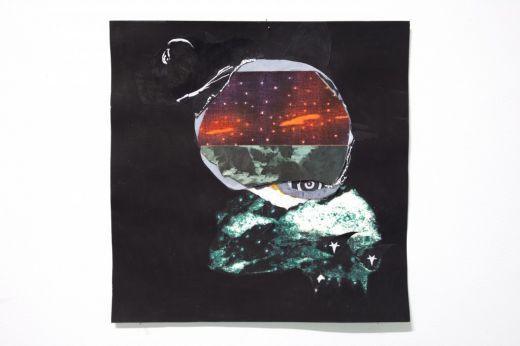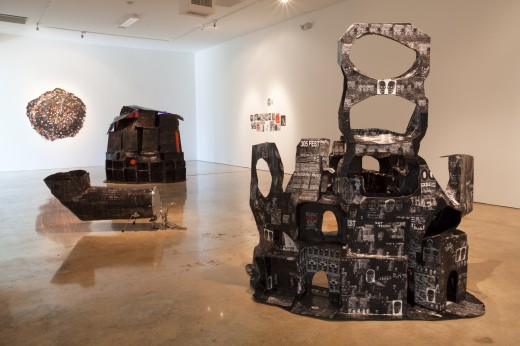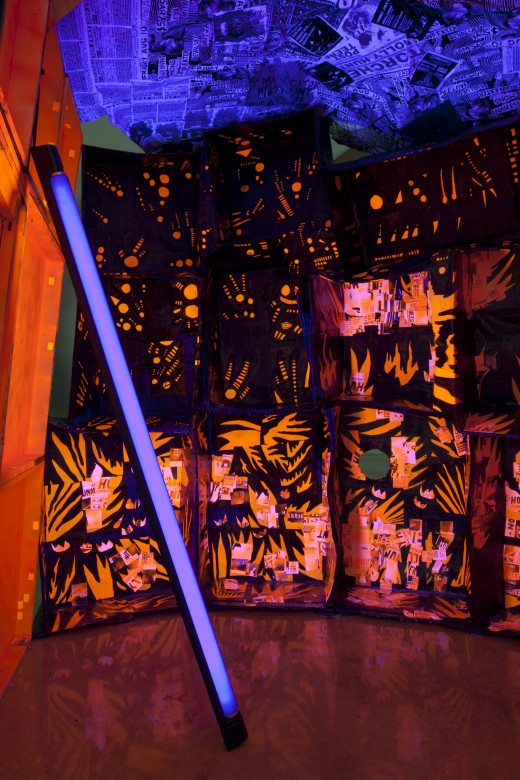- Betty Woodman—CONTRO VERSIES CONTRO VERSIA: An inaccurate history of painting and ceramics

- Alan Gutierrez: Nobody Knows Me Better Than You
Beatriz Monteavaro: Ouroboros
Hunter Braithwaite

Beatriz Monteavaro, The Mind's Eye, 2014. Mixed media on paper. 12 x 12 in.
January 11th – February 21st, 2014
The ouroboros, the snake who has swallowed its tail, can be imagined in several different ways. All involve tail in mouth, caught in an endless cycle of regeneration and rebirth. But if your first impulse, like mine, is to check Youtube, you’re going to see something a bit more bile-splattered. For the sake of the snake, perhaps its best to consider this pose in stasis, one of eternal lockage, as opposed to an ever-tightening cincture. Here, you could imagine at as the two ends of chain draped around Sid Vicious’s neck and then locked together.
Beatriz Monteavaro is a visual artist and plays drum in the local drone metal band Holly Hunt, and as much as it is possible, her art looks like her music sounds. Those are the two ends of that hungry snake, and this, her first Miami exhibition in five years, is their salivating fusion.
When one walks into Emerson Dorsch’s recently renovated space, they first encounter a line of nine works on paper, each one-square foot and handsomely framed. If they have the look and the dimensions of album covers, it’s because they are prototypes for the cover art of Holly Hunt’s 2012 LP Year One. With a feel somewhere between the space opera sci-fi and a bedroom-wall collage, the pieces look campy and raw, teenage of years past, psychedelic in that TV-on-the-fritz kind of way. They are all made with black ink, micron pen, and collaged elements (mostly recycled flyers for an unplayed Holly Hunt gig at the Electric Pickle). As such, the collages are deeply connected to the subcultures they advertise, and the most jarring and subversive use of black are those prim and proper square frames that naturalize them within the gallery’s bright Chelsea foyer.

Ouroboros, Installation View.
This repurposing and reuse of materials defines the four sculptures that fill out the space. Two are cavernous groups of stalagmites, spurting out of the floor: “Gramps Mountain: Evil Stronghold of Gersten” and “Castle Churchill’s: Fortress of Mystery and Power,” which are equally inspired by two local bar/venues, science fiction props, and the playsets that came with the He-Man and Skeletor action figures. They’re created out of whatever paper Monteavaro had at hand—bills, junk mail, kitty litter boxes—and then coated with a runny coat of black ink and Elmer’s glue. The final layer is a partially obscured collage of show flyers for Holly Hunt and other bands. Since there is no music, no sweat and spilled whiskey sodas, these flyers are the closest link we have to the Monteavaro’s musical career. Cheap and xeroxed, the flyer flips the preciousness of the normal music collector. It is something that you print in bulk and then try to get rid of. It becomes something before the fact, something primal and inchoate and loud, as opposed to a quite museal relic. It brackets the live performance, surrounds it like two tours of speakers.

Beatriz Monteavaro, Clubhouse, 2014. Interior view.









